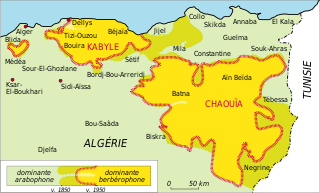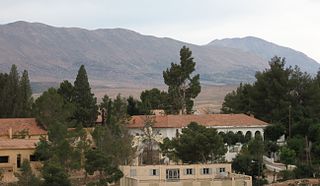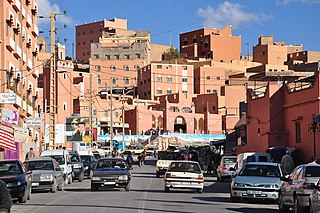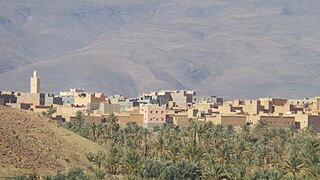Notes and references
- ↑ Michaël Peyron, Contribution à l'histoire du Haut-Atlas Oriental : les Ayt Yafelman », dans "Revue de l'Occident musulman et de la Méditerranée",1984, Vol. 38
The Ait Yafelman (Berber: Ayt Yafelman) are a large Berber tribal confederation of the eastern High Atlas of Morocco, with their capital at Imilchil. They consist of four tribes: Ayt Morghad, Ayt Haddidou, Ayt Izdeg and Ayt Yehia. These tribes created the alliance in the 17th century to counter the expansion of their Ait Atta neighbours. The Ait Yafelman speak Central Atlas Tamazight.
The Ayt Yafelmans lived before the 16th century in the south of the Oriental High Atlas, in the Todgha, the Ghriss, the Dades, the Imedghass and Upper Ziz Gorges.
From the sixteenth century they exceeded the passes of Jbel El Ayachi and Jbel Maaskar to occupy the vast land they live today, and M. Peyron limited as follows: "the whole High Atlas between Tounfite, Midelt and Tizi N'Telghoumt to the North, and Msemrir, Goulmima, Errachidia and Boudnib to the South; and the valley of the Oued Ait Aissa as the furthermost line of spreading to the East, and the upper Oued El Abid, the Assif Melloul and Dades to the West. [1]
This vast territory is therefore in direct contact with this tribes:
The country where the Yafelmans live is a mountainous area where Jbel El Ayachi rises to 3737 meters.
The Zenati languages are a branch of the Northern Berber language family of North Africa. They were named after the medieval Zenata Berber tribal confederation. They were first proposed in the works of French linguist Edmond Destaing (1915) (1920–23). Zenata dialects are distributed across the central Berber world (Maghreb), from northeastern Morocco to just west of Algiers, and the northern Sahara, from southwestern Algeria around Bechar to Zuwara in Libya. The most widely spoken Zenati languages are Tmazight of the Rif in northern Morocco and Tashawit Berber in northeastern Algeria, each of which have over 3 million speakers.

High Atlas, also called the Grand Atlas, is a mountain range in central Morocco, North Africa, the highest part of the Atlas Mountains.

The Chaoui people or Shawia are a Berber ethnic group native to the Aurès region in northeastern Algeria which spans Batna and Khenchla, Oum El Bouaghi provinces located in and surrounded by the Aurès Mountains.

The Kabyle people are a Berber ethnic group indigenous to Kabylia in the north of Algeria, spread across the Atlas Mountains, 160 kilometres (100 mi) east of Algiers. They represent the largest Berber population of Algeria and the second largest in North Africa.

Jbel Ayachi is one of the highest mountains in North Africa, and anchors the Eastern High Atlas in central Morocco. Jbel Ayachi rises to a height of 3,757 m above sea level.

Central Atlas Tamazight or Atlasic is a Berber language of the Afroasiatic language family spoken by 2.3 million in the Atlas Mountains of Central Morocco as well as by smaller emigrant communities in France and elsewhere.
Dr. Michael Peyron is a specialist in the field of Berber language, literature and culture. He is also well known as a writer on tourism in Morocco.

Zayanes are a Berber population inhabiting the Khenifra region, located in the central Middle Atlas mountains of Morocco.

Boumalne Dades is a city in Tinghir Province, Drâa-Tafilalet, Morocco. According to the 2014 census, it had a population of 12,328.

Skoura is a town in Ouarzazate Province, Drâa-Tafilalet, Morocco. It consists of a modern town as well as a historical oasis and palmeraie with traditional rammed-earth architecture.

The Ait Atta are a large Berber tribal confederation of South eastern Morocco, estimated to number about 330,000 as of 1960. They are divided into "five fifths", all said to descend from the forty sons of their common ancestor Dadda Atta: these "fifths" are the Ayt Wallal, Ayt Wahlim, Ayt Isful, Ayt Yazza and Ayt Unbgi. They speak Tachelhit and Central Atlas Tamazight..
Ait Seghrouchen Berber, or Seghroucheni (Seghrusheni), is a Zenati Berber language of the Eastern Middle Atlas Berber cluster. It is spoken by the Ait Seghrouchen tribe inhabiting east-central Morocco.

The Jbel Saghro or Djebel Sahrho is a mountain range in south- east Morocco. It is located south of the High Atlas and east of the Anti-Atlas in the northwest of Africa, northeast of Taliouine and southwest of Ouarzazate.
Sidi Ali ibn al-Mekki Amhaouch (1844–1918) was a Moroccan religious leader who opposed the French conquest of Morocco. Amhaouch was descended from a long line of marabouts who were influential religious figures in Morocco from 1715. Amhaouch backed two rebellions against the Moroccan government and later fought against the French occupying forces. He declared a defensive jihad against France during the Zaian War but died of natural causes in 1918, three years before the war ended in the tribesmen's defeat. His son, Sidi El Mekki Amhaouch, continued to fight the French until his defeat in 1932. Amhaouch's descendant is a religious leader in modern-day Morocco.

The Principality of Debdou was an autonomous hereditary viceroyalty that existed in eastern Morocco from 1430 to 1563, with its capital at Debdou. It was governed by the Ouartajin, a dynasty of Berber descent, related to the Marinids and Wattasids.

The Zawiya Dila'iya, also known as the Zawiyaof Dila and the Dila'iya Sultanate, was a Sufi brotherhood, centred in the Middle Atlas range of Morocco.

The Battle of Taghit was the siege of a fort held by a contingent of the French Army of Africa against Moroccan tribesmen during the South-Oranese Campaign.

N'Kob is a rural municipality in the Zagora province, in the Atlas Mountains. It is located at approximately 30°52′10.594″N5°52′1.652″W, near the Jbel Saghro and 24 kilometers from Tamsahelte. N'Kob is situated 35 kilometers west of the commune of Tazzarine and 40 kilometers from the intersection with the Draa Valley (Tansikht), the most spectacular stretch of the N9. The village has 45 Kasbahs and is surrounded by two oases full of palm trees, numerous of these ancient kasbahs have now been renovated and became hotels. The most widely spoken language in this region is Shilha (Tamazight). According to results of the 2014 general census of the population and households, the village has a population of about 7,209 people.
Si Amar U Said Boulifa was an Algerian Kabyle Berberologist and teacher.

Zawiyet Sidi Amar Cherif, or Zawiyet Sidi Daoud, is a zawiya school located in Boumerdès Province in Algeria.